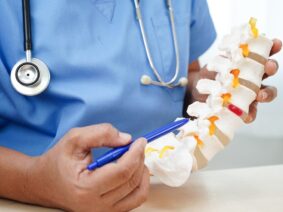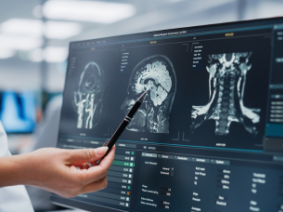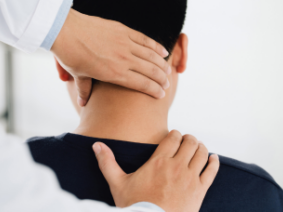What is Spondylosis?
Spondylosis is a type of arthritis caused by wear and tear to the spine. Aging can cause the degeneration of the discs and joints in the spine, sometimes causing the growth of bone spurs, which can impact the spine’s movement and affect the nerves and other functions. Spondylosis is commonly found in people over 50.
There are three main types of spondylosis:
- Cervical spondylosis. Cervical spondylosis affects the joints in the cervical spine, or the neck. Known also as cervical osteoarthritis or neck arthritis, it develops from the wear and tear of cartilage and bones and is often the result of aging.
- Thoracic spondylosis. Thoracic spondylosis affects the joints in the middle of the spine and is less common than cervical spondylosis. Because of the decreased burden in the thoracic spine, spondylosis in this area usually only occurs if there have been problems with another part of the spine first.
- Lumbar spondylosis. Lumbar spondylosis affects the joints in the lumbar spine, or lower back. Like cervical spondylosis, it develops from degeneration of vertebrae.
Causes
The most common cause of spondylosis is general wear and tear from age. The spine helps support most of the body’s weight and carries and protects many of the main nerve branches that run from the brain. Over time the soft, rubbery tissue that separates the vertebrae, called intervertebral discs, become drier, thinner, and harder and lose some of their cushioning ability. The loss of these tissues makes the spine stiffer and back movement less smooth as friction increases.
In an attempt to correct itself, the spine will sometimes grow bony formations called bone spurs to try to make the spine stronger. However, the extra bone can press on delicate areas, like the spinal cord or nerves, resulting in pain.
Trauma from an accident or overuse from athletics can also accelerate spondylosis. Even some occupations, such as construction work or work involving heavy lifting, can put extra pressure on the spine, resulting in early wear and tear.
Risk Factors
Daily wear and tear are the general cause of spondylosis, but people can be affected differently depending on individual risk factors, which include:
- Obesity or being overweight
- A sedentary lifestyle
- A job that requires repetitive or weight-bearing movements involving the spine
- An injury to the spine or spinal surgery
- A neck injury
- Smoking
- Mental health conditions like anxiety or depression
- A genetic predisposition
- Psoriatic arthritis
Symptoms
Spondylosis doesn’t often cause noticeable symptoms, but when it does, it can cause stiffness, soreness, or both. When pain is involved, it is often because changes in the discs are pressing on nerves that extend from the spinal canal. Other symptoms include:
- A stiff back in the morning
- Low back pain
- A grinding, popping feeling when moving the spine
- Muscle tightness or spasm
- Muscle weakness
- Numbness, tingling, pain, and weakness in the legs, called radiculopathy
- Headaches that occur mostly in the back of the head
- Tingling or numbness in the shoulders or arms
If a sudden onset of numbness or tingling in the shoulder, arms, or legs, loss of balance, or loss of bladder control is experienced, immediate medical attention is needed. This can indicate serious nerve dysfunction and lead to permanent nerve damage.
Treatment
Most cases of spondylosis can be treated with nonoperative therapies. These conservative methods include many therapies used to manage symptoms.
- Physical therapy. A physical therapist will suggest customized exercises specific to the patient’s symptoms, as well as oversee proper techniques to avoid injury.
- Low-impact exercise. Low-impact exercise, such as core-strengthening exercises, can be done at home. These exercises should focus on improving posture, range of motion, muscle flexibility, spine muscle strength, weight management, and overall fitness.
- Back support. Choosing a chair or mattress that emphasizes back support can relieve symptoms.
- Anti-inflammatory medications. Nonsteroidal anti-inflammatory drugs, or NSAIDs, such as ibuprofen or acetaminophen can help with pain relief. If these drugs don’t work, a doctor can prescribe stronger pain medication.
- Steroid injections. Injections of steroids, such as prednisone, can be administered by a doctor and temporarily reduce tissue inflammation and lessen pain.
If the condition worsens or doesn’t respond to other forms of treatment, surgical options can be considered. Surgery can relieve pressure on nerves and alleviate pain. Surgery might also be needed if pinched nerves cause serious numbness, weakness, or loss of bowel and bladder control. Surgical options include:
- Discectomy. This surgery removes an injured disc pressing against nerves.
- Laminectomy. This procedure removes the lamina, or bony plate on the back of the vertebrae, being affected by spondylosis to take pressure off the spinal nerve root or spinal cord.
- Laminoplasty. This changes the position of the lamina to create more room for nerve tissue within the spine.
- Spinal fusion. This procedure connects part of the spine with transplanted bone in order to stabilize the spine.
If you are having symptoms of spondylosis, don’t ignore them. Contact Neurological Associates of Central Jersey to create your individualized treatment plan today.



